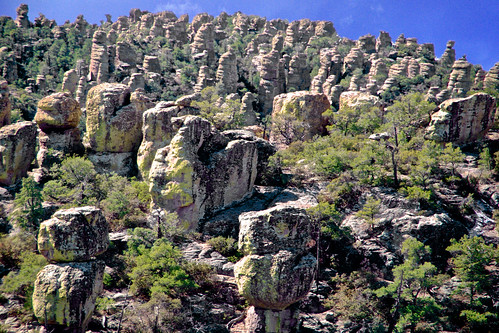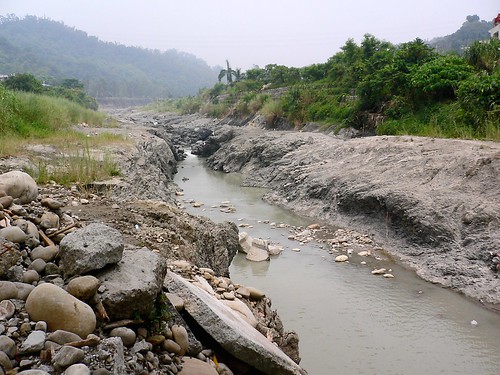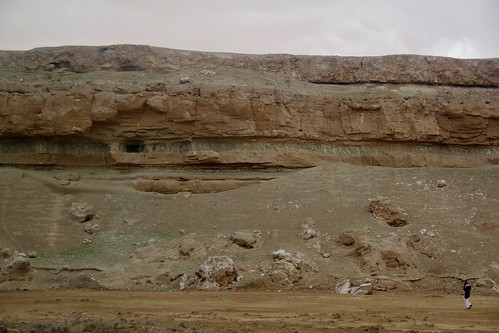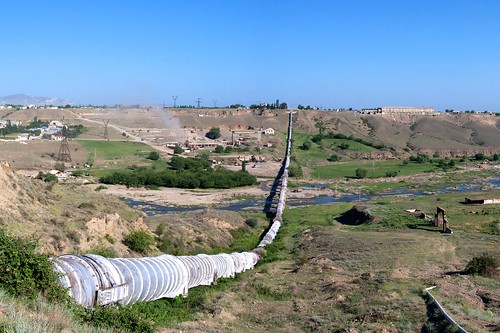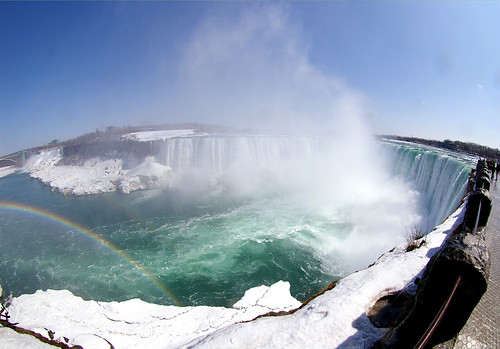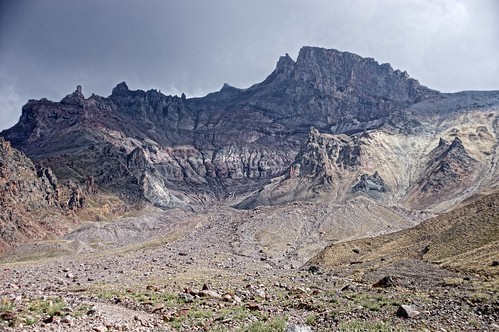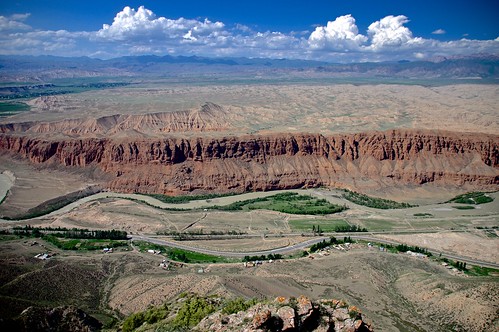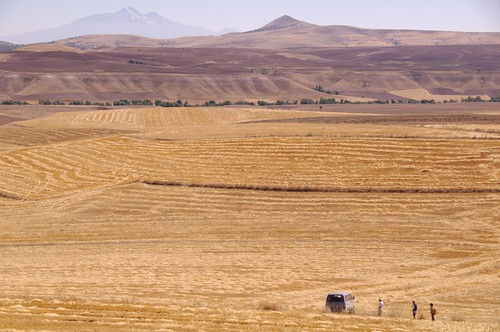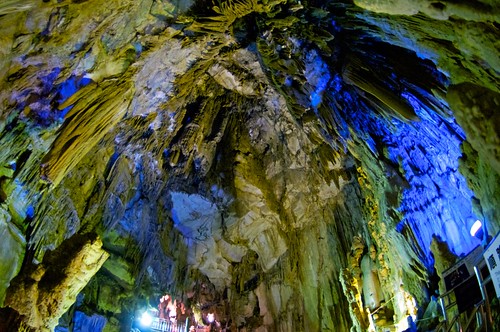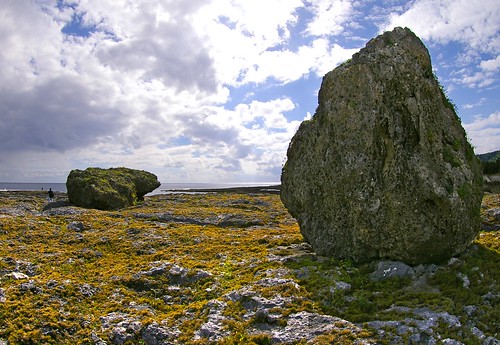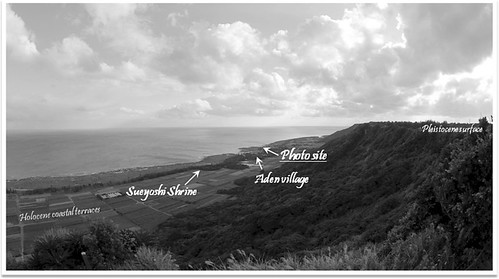DYNAMIC EARTH
2020/05/28
Three-dimensional point cloud of slope failures in the Sensuikyo Valley (Aso City, Kumamoto, Japan) obtained by UAS-based SfM-MVS photogrammetry / UASとSfM多視点ステレオ写真測量を用いた3次元点群モデルの例(熊本県阿蘇市仙酔峡)
This is an example of 3D point cloud by Structure-from-Motion (SfM) Multi-View Stereo (MVS) photogrammetry. The 3D point cloud was produced from thousands of aerial photographs taken by small unmanned aerial vehicles (UAV), or unmanned aircraft or aerial system (UAS). The spectrum of colors indicates different information given to each point: red-green-blue (RGB) color, normalized differential vegetation index (NDVI) calculated using a near infrared camera data, topographic shade by eye-dome lighting (EDL), morphological roughness, and surface curvature. These data are readily obtained by SfM-MVS photogrammetry, and can be effectively used for various applications in geomorphology and related studies. For more details on SfM-MVS photogrammetry, see our review article in this issue (p. 321-343).
(Yuichi S. Hayakawa, Hiroyuki Obanawa, Hitoshi Saito, Shoichiro Uchiyama)
www.researchgate.net/publication/304674520_SfMduoshidians...
2020/05/21
Dashgil Mud Volcano at Gobustan, Azerbaijan / ダシュギル泥火山(アゼルバイジャン共和国)
Numerous mud volcanoes are present in both offshore and onshore areas around Baku on the western coast of the Caspian Sea. Geomorphological studies have been carried out in the Dashgil Mud Volcano, located 50 km southwest of Baku, next to the Gobustan National Park that is a World Heritage with its cultural landscapes with prehistoric rock arts. The Dashgil has a 3-km diameter and 100-m summit elevation, and similar mud volcanoes are densely present in this region. "Dash (daş)" stands for rock or stone, while "gil" means clay. Normally, activities of these mud volcanoes are moderate with the continuous eruption of relatively cold materials including mud, water, and gas, but they can occasionally erupt massive gas to "explode" with flames hundreds of meters high.
カスピ海沿岸に位置するアゼルバイジャンの首都バクー周辺には、海底だけでなく陸上にも泥火山(でいかざん)が多数噴出している。地形学的な研究も行われているダシュギル泥火山は、バクーから南西に約50 km。近辺には、先史時代の岩絵などの文化的景観が世界遺産として登録されている、ゴブスタン国立保護区がある。ダシュギルは、直径3 km、標高100 m ほどの山であり、周辺にも同様の規模の泥火山が密に分布する。名称のダシュは石・岩、ギルは泥・粘土をあらわす。このような泥火山は、普段は穏やかに泥や水、ガスを噴出しているが、時折、何らかの要因で大量に放出されたガスが発火し、数百m もの高さの炎をともない「噴火」することがある。
2020/05/14
Hoodoos in Chiricahua National Monument, Arizona (USA) / チリカウワ国立公園の奇岩群(アメリカ合衆国)
A large amount of rock monuments, composed of rhyolite welded ignimbrite by the Turkey Creek caldera eruption 27 million years ago, are present in this arid hilly land. Weathering and erosion along weak lineaments (joints) caused the formation of the tors, some of which are gravitationally displaced but keep superb balance before collapsing. Extensive wildfire (Horseshoe Two Fire) occurred in May-June 2011 to burn ca. 90,000 ha in this area.
乾燥したアリゾナの台地に多数の岩が林立する。約2700万年前のターキークリークのカルデラ噴火による流紋岩質の溶結火砕流堆積物からなる。弱線沿いに風化と侵食が進み、傾きつつも絶妙なバランスで崩落を免れている岩も多く見られる。2011年5〜6月には大規模な山火事でこの付近の9万haが焼けた。
2016/04/19
prompt 3D mapping of the earthquake-triggered lansdlide in Minami-Aso, Kumamoto, Japan
The series of earthquakes in Kumamoto (western Japan) in April 2016 triggered a large amount of landslides in the area around Mt. Aso.
"Crisis Mapping" on OpenStreetMap is one of the cases that people in areas away from the earthquake-affected area can contribute to enrich the geographical information shown on online maps.
http://tasks.hotosm.org/?sort_by=priority&direction=asc&search=kumamoto
http://crisismappers.jp/about.html
If with the technique of SfM-MVS (Structure-from-Motion Multi-View Stereo) photogrammetry, one can contribute to visualize geographical information in specific areas with more details, in 3 dimensions.
Here is an example of the landslide occurred near the former Aso Bridge (which was destroyed away) in Minami-Aso region. Among else, this landslide was the largest and most distinct one related to the earthquakes.
Soon after the landslide was triggered by the midnight earthquake, many organizations began to obtain the aerial videos and images to be distributed online.
As a prompt trial, I used a newscast video taken from a manned helicopter. The original video by Fuji News Network is found at: http://headlines.yahoo.co.jp/videonews/fnn?a=20160416-00000923-fnn-soci
Although the resolution, sharpness and locational accuracy were not so high, this prompt result was good enough to help understanding the positional details of the landslide.
3D model generated from the newscast video
2-dimensional geographic information
Orthorectified photograph, hillshade image and topographic contour lines (with 100-m grid, north-up)
# Below is a previous trial when a gigantic landslide occurred in Afghanistan in 2014; at that time only still images were available.
北東アフガニスタンの斜面崩壊:報道写真からの3Dデータ作成 / 3D data construction of the landslide in northeastern Afghanistan from reported photographs
Then, using aerial images (oblique views) taken from a manned aircraft operated by GSI (Geospatial Authority of Japan), a 3D model and 2D map information were generated.
The images used are also shown at the top of this article.
Because the images had their positional information probably by camera-mounted GPS/GNSS receiver, the georeferencing of the 3D model was readily performed (however some errors may remain). The quality of the 3d model (resolution etc) was actually much better than that from the prompt newscast video.
3D model generated from the aerial oblique images
The 3D model exported to a KML file enables to compare the conditions before and after the earthquake on Google Earth.
2D geographic information
Orthorectified photograph, hillshade image and topographic contours with 100-m grid.
A zoom-up view (orthomosaic image and topographic contours):
Furthermore, using a video taken by an unmanned aerial vehicle (UAV, namely Drone) provided by GSI, more precise 3D model was generated.
Although the data is a video (not still images), the resolution of the images taken from the lower height is high enough to reconstruct the detailed features of the landslide. When we watch a video taken by a UAV, we may be able to recognize the detailed information of the objects in the video, but further information can be obtained if the images are projected onto a geographic space, i.e., the images are appropriately "mapped". Particularly, mapping of such information enables to find the changes of landscapes or landforms by comparing with existing map data. Here I put 6 GCPs (ground control points), whose geographical coordinates (XYZ) were obtained from an online map GSI Maps to refine georeference results. However some errors (several to tens of meters) may remain in the model - to correct this, it would be necessary to put more accurate coordinates of the GCPs.
Original video taken by UAV
provided by GSI
http://www.gsi.go.jp/BOUSAI/H27-kumamoto-earthquake-index.html
3D model generated from aerial video by UAV
Note that the area of coverage of images/videos by a UAV is limited due to some reasons (ability of flight, legal restrictions) compared to a manned aircraft. The UAV-derived model above actually lacks data in surrounding areas of the landslide.
Then the data by manned and unmanned aircrafts are merged to create a more complete model of the landslide and surroundings. A wide area can be covered by the images from high-altitude manned aircraft, while more detailed shape can be obtained by the pictures from low-altitude UAV. The 3D data is shown online as a point cloud. The point cloud was first generated using SfM software PhotoScan (Agisoft), and then it was tiled and optimized to be shown online by using "laspublish" function in LAStools (rapidlasso).
3D point cloud of the landslide obtained by both manned and unmanned aircrafts
http://www.csis.u-tokyo.ac.jp/~hayakawa/pointclouds/160416_aso_bridge_landslide_gsi/sfm_airphotos.html
The WebGL system, "potree", also enables to perform some basic measurements of the point cloud, including calculation of distance, angle, area and volume, as well as extraction of swath profiles. Such functions are found in the left-side pane of the browser.
In addition, one can download the original point cloud data in LAZ format. Geographic projection is Japan Plane Rectangle CS II (JGD 2000 Datum). One may use free software such as LAStools (lasview function), CloudCompare and QuickTerrainReader (free version).
Using such the three-dimensional data, further observation and analyses would become possible to obtain further insights into the landslide phenomena. For instance, one may think about the landslide damming of the river and following outburst flood, which could have caused further erosion and landslides on the valley-side slopes downstream, from differing points of view in the 3D data.
阿蘇大橋を流した斜面崩壊:速報的リモート3次元計測
熊本の一連の地震活動により、阿蘇地域においても多数の斜面崩壊が発生した。
発災後すぐに、状況を把握するために、遠方にいる者ができることとして、地図づくりがある。
一つはOpenStreetMapというオンライン地図に情報を書き込んでいくというものである。クライシスマッピングと呼ばれている。
http://tasks.hotosm.org/?sort_by=priority&direction=asc&search=kumamoto
http://crisismappers.jp/about.html
インターネットに接続されていれば、「だれでも」「どこでも」作業ができるため、参加の敷居も低い。
基本的には、2次元の情報を地図に集約するというものである。
一方、3次元的により細かな情報を可視化することもできる。
SfM多視点写真測量という技術を用いて、報道された動画や画像から、3Dモデルや2次元地図画像を生成することが可能だ。
以下には、阿蘇大橋の付近(南阿蘇村立野)で生じた斜面崩壊について紹介する。
今回の地震にともなう斜面崩壊は、実際はここだけでなく、各所多数生じている。
これはその中でもとくに規模の大きい崩壊であった。
斜面崩壊の発生後、各組織が有人機により撮影した空中写真や動画を、オンラインで提供し始めた。
そのうち、速報的な報道映像からの3Dモデル生成をまずは試みた。
FNN http://headlines.yahoo.co.jp/videonews/fnn?a=20160416-00000923-fnn-soci
解像度、鮮明度や位置精度は低いが、速報的な意味では「どこがどう崩れたか」といった理解を助けるものにはなった。
報道映像から生成した3Dモデル
2次元情報(地図)
オルソ補正画像(正射投影)、地形陰影図、等高線の表示(1グリッド=100 m)
※以前、アフガニスタンで大規模な斜面崩壊が起きた際も似たようなことを行った。この時は動画はなく、静止画のみが利用可能だった。
北東アフガニスタンの斜面崩壊:報道写真からの3Dデータ作成 / 3D data construction of the landslide in northeastern Afghanistan from reported photographs
次に、国土地理院から提供された斜め空中写真を用いて、3Dモデルと2次元地図情報の生成を試行した。
使用した画像は、このページの最上部に示したものだ。
写真画像に撮影位置情報が含まれていたので、位置合わせは容易だった(ただしその撮影位置にも誤差があるため、結果としてモデルの位置精度もそれに依存する)。
生成されたモデルも、静止画を利用していることもあり、報道映像から切り出した画像よりずっと高精細に再現できている。
斜め空中写真から生成した3Dモデル
これをKMLにエクスポートし、Google Earth 上で表示することで、崩壊前後の簡便な比較ができる。
2次元情報(地図)
オルソ補正画像(正射投影)、地形陰影図、等高線の表示(1グリッド=100 m)
拡大図
さらに、国土地理院が撮影した小型UAV(無人航空機、通称ドローン)による動画からのモデル生成を行った。
有人機よりも低空で撮影されているので、より高解像度に現況を見ることができる。動画だけでももちろん充分に分かりやすいのだが、それを地理空間に投影する、つまり地図化すると、その前の状況との比較も可能となり、さらに理解を深める助けとなろう。
なお、ここではGCP(地上制御点)を6個ほど設置し、地理院地図からその地理座標(XYZ)を得て、できる限りの位置補正は行った。ただし、地理院地図からの座標値取得でも誤差は避けられないので、数メートルから十数メートルの位置誤差は仕方ない範囲となる。
元の動画(UAVによる撮影)
http://www.gsi.go.jp/BOUSAI/H27-kumamoto-earthquake-index.html
UAV動画から生成した3Dモデル
ただし、UAVによる撮影はその飛行能力等の制限から、有人機によるより高高度からの撮影と比べると、カバーできる範囲が限られてしまう。上のUAVによるモデルでも、崩壊面の周囲はデータの欠落が多い。
そこで、有人機によるデータと無人機(UAV)によるデータを合成し、広範囲をカバーしつつ、部分的により高解像度な情報を見ることができるような3次元データを作成した。
これは、点群データとしてオンライン表示できるようにしてある。
有人機による斜め空中写真とUAVによる低空動画から生成された合成3Dモデル
http://www.csis.u-tokyo.ac.jp/~hayakawa/pointclouds/160416_aso_bridge_landslide_gsi/sfm_airphotos.html
ここで使用している点群データ表示システム(potree)では、ウェブブラウザ上で距離、角度、断面、体積といった簡易計測が可能だ。
画面左上のボタンを押すと、画面左側にメニューが表示される。
(点の色わけや、影をつける、点の形を変えるといったことも可能)
使用説明(日本語)(阿南測量設計提供)も参考に、いろいろと試してみると良いかもしれない。
加えて、ここでは点群データそのものもダウンロード可能としている。
平面直角II系(JGD2000)に投影されたLAZ(点群データの汎用的なファイルフォーマットの一つ)データとしてダウンロードできるので、点群データのヴューアソフト(たとえばLAStools (lasview)、CloudCompare、QuickTerrainReader(フリー版)など)でローカル環境で表示、分析も可能だ(ただし位置座標には誤差が含まれる)。
こうした3次元データを利用して、いろいろな観察や考察を深めることもできる。
たとえば、この斜面崩壊に関連する河道閉塞(河川のせき止め)とその決壊洪水や、それに伴う副次的崩壊の特徴など、動画や画像だけではわかりにくいものが、視点を変えて覗き込むと、鮮明に見えてくるのだ。
2015/06/05
Bedrock erosion by waterfall recession after the 921 Chi-Chi earthquake, central Taiwan / 台湾中部,九二一地震で生じた滝の後退による岩盤侵食
The Chi-Chi earthquake (M7.7), occurred on September 21, 1999, was associated with the activity of the Chelungpu Fault, along which surface ruptures continues for ca. 100 km with up to 10 m of vertical displacement. Waterfalls were formed in rivers flowing over the ruptures, and the most famous one having a height of 7 m was appeared in the Tachia River at the northernmost portion of the fault. The picture shows a fault-induced waterfall with 4-m height (at the center, slightly seen as white color) and a gorge of inner channel downstream of the waterfall in the Gan River in July 2005. This waterfall has receded for more than 200 m from the original location in 6 years after the earthquake, where rapid waterfall recession can be caused by abundant gravels transported from upstream areas with harder rocks, acting as abrasion material. We can also observe sidewall notches and downstream widening of the gorge, which suggest lateral erosion by the river following the waterfall recession. On the right side of the Gan River, facilities of formerly an elementary school, located just on the fault rupture and broken by the earthquake, are preserved and on exhibit as the Earthquake Museum.
(July 26, 2005, photo and text by Yuichi S. Hayakawa)
1999年9月21日,台湾中部でM7.7 の大地震が発生した。この際活動した車籠埔断層に沿って,地表には約100 km に渡る地震断層が生じ,その鉛直変位量は最大で10 m に及んだ。断層が河川を横切る地点は滝となり,とくに断層北部の大甲渓で高さ7 mの滝が形成されたことは多く報じられた。写真は,断層を跨ぐ河川の一つである乾渓において,2005年7月に撮影されたものである。細長く続く峡谷(inner channel)の奥に高さ約4 m の滝があり,この滝は地震発生から6年の間に元の断層の位置から200 m 以上も後退した。年間で数十メートルという後退速度は,岩盤侵食速度としては極端に大きい。これは,風化に対して脆弱な泥質の岩盤であることに加え,上流域から運搬されてくる硬質な砂礫が摩耗剤としてはたらき,侵食作用を促進させていることが一因であると考えられている。また,峡谷は下流ほど幅が広がり,その側壁にはノッチが形成されており,滝が後退したあとの側刻作用による谷の拡幅を示している。この乾渓右岸,断層の真上にあった学校は,その倒壊した建物や盛り上がった校庭が,地震教育園として保存・公開されている。
解説・写真:早川裕一
2015/04/08
Cliff of fluvial terrace along the Euphrates River near Ar-Raqqa, Syrian Arab Republic / シリア共和国ラッカ近郊、ユーフラテス川右岸の河岸段丘崖
(March 7, 2010, photo by Yuichi S. Hayakawa)
ビシュリの台地の北縁は、ユーフラテス川により切り込まれ比高60 m ほどの段丘崖をなす。崖は中新統の石灰岩・石膏岩と挟在するシルト質泥岩からなるが、1974年のタブカダム建設以降ユーフラテスの氾濫は抑えられ、現状、崖が侵食されることはほとんどない。
2015/04/07
Erosional landforms of layered, non-welded ignimbrites in Cappadocia, Turkey / トルコ共和国、カッパドキアにおける火砕流堆積物の侵食地形
The rock mound on the right side is an inserberg named Uçhisar, in which many artificial caves are formed. Visited during the field trip of JGU-Ankara University joint meeting.
(September 16, 2010, photo by Yuichi S. Hayakawa)
非溶結の火砕流堆積物が風化・侵食を受け、奇岩地形が広がっている。右側の岩山はウチヒサルと呼ばれる残丘地形。多くの洞穴が掘られている。JGU合同大会(アンカラ大学との共催)の巡検で訪れた。
2015/04/06
Deeply dissected valley in an alluvial fan of the Tovus River, western Azerbaijan / アゼルバイジャン共和国西部、トヴス川扇状地の開析谷
July 25, 2012, photo by Yuichi S. Hayakawa
小コーカサス山脈から北流(写真左から右)するトヴス川は、本流であるクラ川に注ぐところで北向きの扇状地を形成する。その開析谷の比高は写真の地点で約60 m に及び、谷の内部には後氷期に形成された数段の段丘がみられる。現河床からは礫の採取も活発に行われ、対岸ではその工場からの煙が立ち上がっている。扇状地上を東西に流れる灌漑用水は、径2 m 超のパイプを通り、サイフォンとしてトヴスの深い谷を横断する。
2015/02/03
Erosion of Niagara Falls, Canada and the USA / ナイアガラフォールズの侵食
Niagara Falls was formed at the Niagara Escarpment, 11 km downstream the present location of the waterfall, on ca. 12,500 years ago when the Niagara River drained from upstream Lake Erie across the cliff. The mean recession rate is ca. 1 m/y, while the long-term recession rate has varied due to changes of water discharge of the Niagara River. Water intake for power plant since a century ago caused decrease of the water discharge flowing over the waterfall, and the waterfall erosion has been stagnated, with its present recession rate on the order of centimeters a year. The embowed horseshoe shape of the waterfall can also be another factor stabilizing the waterfall against erosion.
An erosion model on Niagara Falls has been proposed by G.K. Gilbert a century ago, suggesting the caprock structure of the waterfall face, in which erosion dominates on the lower shale layer (undercut by plunge-pool swirling flow). Although the model has long been regarded as representative one that explains waterfall erosion, such a caprock model cannot be applied for many other waterfalls that are buttressed, and severe erosion in the plunge pool is also doubtful because currents in the deep pool may not be so strong to cause entrainment of fallen brocks and bedrock erosion.
Photo and text by Yuichi S. Hayakawa
ナイアガラフォールズは約12,500 年前,ローレンタイド氷床の後退にともない,エリー湖からオンタリオ湖へ向けて北流したナイアガラ川が,東西に走るナイアガラ・エスカープメントを横切る地点で形成された。以降,継続的な侵食により滝は現在の位置まで約11 kmを後退した。平均して年間約1 m 弱の後退速度となるが,過去の後退速度は一定ではなく,たとえば約1万年前からの5000年間は,エリー湖より上流の氷河湖からの流出経路が異なったため,1 kmしか後退が進まなかったことが貝化石の14C 年代(未較正)から推定されている。また,20 世紀には水力発電のための取水が始まり,観光用に日中の流量は確保されているものの,滝を通過する総流量は激減した。同時に滝の侵食も遅くなり,現在の後退速度は年間数 cm 程度であると言われている。また,ホースシューフォールズ(写真手前)は300 年前にはより直線的な平面形状を呈していたが,これが徐々に馬蹄形となることで応力分散により安定し,侵食が遅くなる一因となっているという説もある。
20世紀初頭に提案されたG.K. Gilbert によるナイアガラフォールズの侵食モデルは,滝壺の渦流が滝面下部の頁岩の水平層を侵食し,キャップロックとなる上部のドロマイトが崩落する,というものであった。長い間これが滝の侵食の典型的なモデルとして広まっていたが,実際にはキャップロック構造をもたない滝は多く,滝一般においての事例としてはむしろ稀な方であろう。さらに滝壺底部に侵食をもたらすほどの渦流が生じるという説明は,ナイアガラフォールズにおいてさえ推測の域を出ておらず,滝の侵食プロセスに関して不明な点は未だに多い。
2015/02/02
Disappearing glacier in Mt. Erciyes, central Turkey / トルコ共和国中部、エルジエス火山の山頂とその直下に現存する氷河
Disappearing glacier in Mt. Erciyes, central Turkey.
(August 2014, photo by Yuichi S. Hayakawa)
トルコ中部、カイセリ近郊に位置するエルジエス山(山頂標高3,916 m)には氷河や岩石氷河が現存する。しかし1900年代初頭に初めて報告されてから氷河は後退を続けており、現在は山頂直下の崖下にわずかに残るのみとなる(写真中央右)。氷河より下流にはモレーンやアウトウォッシュプレーンなど氷河性の堆積物も分布している。(2014.08)
2015/02/01
The Naryn River and mountains in Naryn, northern Tien Shan (Kyrgiz) / キルギス共和国中部,ナリン高地
The Naryn River and mountains in Naryn, northern Tien Shan (Kyrgiz)
(July 2014, photo by Yuichi S. Hayakawa)
天山山脈の北部,ナリンから北方を望む.写真中央を西に流れるナリン川は,上流の氷河からの濁った水を湛え,その下流ではシルダリヤ川と名を変えアラル海に注ぐ.谷中に形成された段丘面上には,旧石器時代に遡る遺跡が分布している.(2014.07)
2014/05/08
北東アフガニスタンの斜面崩壊:報道写真からの3Dデータ作成 / 3D data construction of the landslide in northeastern Afghanistan from reported photographs
I tried to construct three-dimensional data from photographs taken by reporters.
使用したのは、以下のようなサイトでも公開されている、様々なソースの写真。最終的に5つの空中写真を利用した。 (はじめは先に公開されていた地上写真からも試みたが、視点が異なり過ぎてうまくマッチングしなかった。)
The photographs from various sources shown in the websites below were used for the 3D reconstruction. Five aerial photographs were successful to be used.
boston.com The Atlantic
PhotoScan(R) を使用し、基準点座標はGoogle Earth から参照しながら、SfM(モーションからの構造解析)による3Dモデルを作成。
Structure-from-Motion (SfM) was performed to create a 3D model from the photographs using PhotoScan(R) software. Coordinates of ground control points (GCP) were obtained by referring to the points in satellite images on Google Earth.
ただしモデル作成後の基準点座標には100 m 近いの誤差も含まれる(Total error = 53.8 m)。
The GCP errors are typically 53.8 m but some are nearly 100 m.
KML(KMZ)ファイルにエクスポートし、Google Earth 上で表示させると、崩壊発生前後の変化がよく読み取れる。
Exporting to KML (KMZ) file, the scenery before and after the landslide occurrence can be seen on Google Earth. [ source KML ]
2014/05/05
Low-relief erosional surfaces and Erciyes Dağı (Mt. Erciyes) volcano in Anatolian highland / アナトリア高原の小起伏面とエルジエス火山(トルコ共和国カイセリ県)
Low-relief erosional surfaces are widely present in central Anatolian highland, where mountains or hills surrounded by gentle slopes are covered with crop fields to their summits. Slopes on these "low-relief" surfaces are generally gentle and geomorphic processes therein seems relatively slow, but many active geomorphic features are actually found: for instance, current small rivers incises for several meters in depth into a wide Holocene floodplain (shown in the center of the photo, a river runs along the trees from left to right), and steep slopes beyond the river have thin soil layer and surface materials are actively transported during heavy rainfall and in snowmelt season. Although the overall form of the low-relief surfaces can be peneplain or a relict landform of ancient long-term erosion, present geomorphic process are not so inactive in the region.
Many active faults run through these low-relief surfaces surrounding the Anatolian highland. A pull-apart basin, divided by normal or slip faults (a part of the East Anatolian fault zone), is located beyond the hill ridge in the upper portion of the photo, where volcanic activities have occurred since several million years ago.
Mt. Erciyes (3,917 m), shown in the upper left of the photo, is the highest volcano in central Anatolia. The mountain provides a place of skiing in winter, and snow around the summit is observable year-round. A glacier is present just below the summit on the north-facing slope (photo), which have severely retreated and is shortly disappearing. The photo shows an amazing scenery which contrast strong sunlight in the close view and cold ice in the distant view.
(Photograph and text by Yuichi S. Hayakawa, Aug. 2009)
アナトリア高原中央部は広く侵食小起伏面からなる。乾燥して高木の乏しいなだらかな山には,その頂上にまで畑が広く覆っている。山や丘のてっぺんには,テペと呼ばれる遺丘が多く乗り,写真もそのうちの一つから撮影したものだ。
「小起伏」面とはいっても,しかし,それなりに起伏はある。道には坂やコーナーが延々と続き,大河川は深い谷を刻む。写真中央遠方の緑の木々に沿っては小川が流れており,数百m幅の広い沖積層を谷底に溜める。その向こうの急斜面は草もまばらで土壌も浅く,豪雨や雪解け時には土砂移動が生じている。小起伏面の概形は,かつての河川等による侵食を反映した残存地形(いわゆる準平原)であると言われる。しかし,現在でもさまざまな地形変化プロセスが,速度は遅くとも,着実に進行していることも事実である。
こうした小起伏面を切り裂く断層帯が,アナトリア小プレートを取り囲むように分布している。写真上,稜線の向こう側には,南西―北東に走る正・横ずれ断層帯に挟まれた盆地が広がる。この地域はテクトニクス的な拡大場にあり,火山活動が数百万年以上も前から続いている。
左に遠望されるのがエルジエス火山(標高3,917 m)。中央アナトリア地方の最高峰である。冬にはスキーリゾートとして賑わい,夏でも山頂付近には雪が残る。写真手前が北向き斜面であり,山頂直下には氷河や岩石氷河も存在する。ただ,この氷河も縮小傾向にあり,一昨年と昨年は史上初めて麓からの遠景で夏に雪が見えなくなったという。なお,奇岩地形で有名なカッパドキアはこの火山の西に広がり,これはエルジエスより古い時代の火山活動にともなう火砕流堆積物の台地が開析されてできている。
(2009年8月撮影)
2014/05/02
Stalactites developed in Abukuma karst cave, northeastern Japan / 福島県あぶくま洞の天井に成長するつらら石
(July 2012, photo by Yuichi S. Hayakawa)


